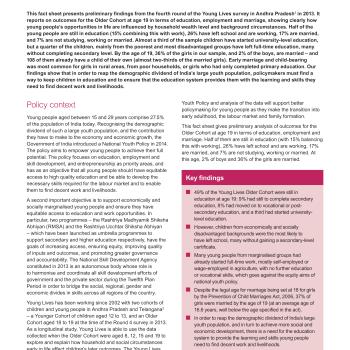Publication Information

This fact sheet presents preliminary findings from the fourth round of the Young Lives survey of children in Andhra Pradesh and Telangana in 2013. It reports on outcomes for the Older Cohort at age 19 in terms of education, employment and marriage, showing clearly how young people’s opportunities in life are influenced by household wealth level and background circumstances. Half of the young people are still in education (15% combining this with work), 26% have left school and are working, 9% are married and not working (mainly young women), and 7% are not studying, working or married. It was surprising that almost a third of the sample children have started university-level education, although children from economically and socially disadvantaged groups were more likely to have left full-time education, many without a secondary-level qualification. By the age of 19, 36% of the girls in our sample, and 2% of the boys, are married – and 107 of them already have a child of their own (almost two-thirds of the married girls). Early marriage and child-bearing was most common for girls in rural areas, from poor households, or girls who had only completed primary education. Our findings show that in order to reap the demographic dividend of India’s large youth population, policymakers must find a way to keep children in education and to ensure that the education system provides them with the learning and skills they need to find decent work and livelihoods.

This fact sheet presents preliminary findings from the fourth round of the Young Lives survey of children in Andhra Pradesh and Telangana in 2013. It reports on outcomes for the Older Cohort at age 19 in terms of education, employment and marriage, showing clearly how young people’s opportunities in life are influenced by household wealth level and background circumstances. Half of the young people are still in education (15% combining this with work), 26% have left school and are working, 9% are married and not working (mainly young women), and 7% are not studying, working or married. It was surprising that almost a third of the sample children have started university-level education, although children from economically and socially disadvantaged groups were more likely to have left full-time education, many without a secondary-level qualification. By the age of 19, 36% of the girls in our sample, and 2% of the boys, are married – and 107 of them already have a child of their own (almost two-thirds of the married girls). Early marriage and child-bearing was most common for girls in rural areas, from poor households, or girls who had only completed primary education. Our findings show that in order to reap the demographic dividend of India’s large youth population, policymakers must find a way to keep children in education and to ensure that the education system provides them with the learning and skills they need to find decent work and livelihoods.

